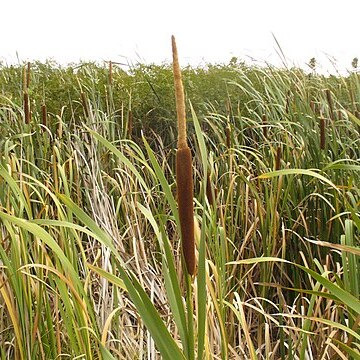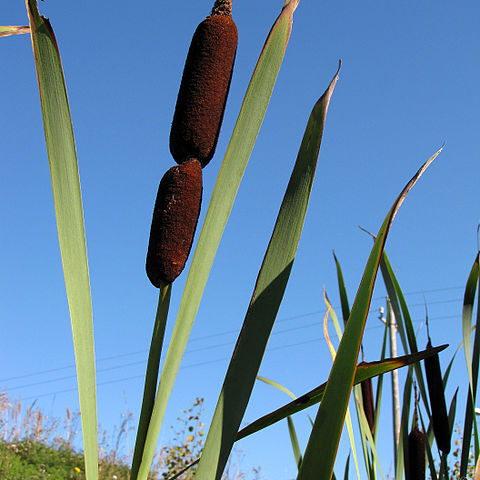Robust, rhizomatous, perennial aquatic herbs, monoecious, mostly glabrous. Stems erect, unbranched. Leaves distichous, the lower portion an open sheath; lamina linear. Flowers numerous, very small, unisexual, protandrous, wind-pollinated, crowded into cylindrical spike-like inflorescences, the male inflorescence above the female. Male inflorescence with linear-lanceolate, caducous bracts at base and 2 or 3 at intervals in spike; floral bracts linear, simple or branched (probably representing perianth); stamens 1-7; filaments connate; anthers basifixed; pistillode lacking. Female inflorescence with tips of floral structures forming a velvety surface; rachis with very short lateral axes each bearing one or several fertile or sterile flowers and bracts; floral bracts very small, hairlike, with a flattened lamina, or bracts absent; fertile flowers with whorls of long straight hairs; staminodes absent; ovary superior; carpel 1; style long; stigma flattened; sterile female flowers either similar to fertile flowers but ovary undeveloped or pistil swollen and clavate (a carpodium). Fruit a very small l-seeded follicle, falling before dehiscence; pericarp membranous.
Herbs, perennial, aquatic or in marshes, with creeping rhizomes. Stems simple or branched, robust or slender. Leaves alternate, distichous, erect, emergent or floating, sheathed at base. Plants monoecious. Bracts leaflike. Inflorescence either of globose heads on upper part of stems and branches with several male and female heads in a panicle, raceme, or spike, male heads above female, or of a single cylindric spike with lower part female and upper part male. Flowers minute, numerous. Perianth segments of 3-6 chaffy elongate scales or absent. Male flowers with 1 or more stamens; anthers basifixed, longitudinally dehiscent. Female flowers bracteolate or with fine hairs at base; ovary 1-loculed, rarely 2-loculed, narrow at base or on a long capillary stalk; styles simple or forked; stigma unilateral, broadened or spatulate; ovule 1. Fruit minute, nutlike, indehiscent, falling off together with stalk if present. Seeds with thin testa.
Rhizomatous herbs with erect unbranched stems. Leaves broadly linear to narrowly elliptic with a long open sheathing base. Inflorescence spike-like, protandrous with contiguous or remote superposed spikes, the upper ?, the lower ?, each with a usually caducous bract at the base, sometimes interrupted by similar bracts. Male flowers reduced to 2–5 stamens; flowers interspersed with linear to laciniate bracteoles. Female flowers sterile and fertile together, with or without a subtending bracteole, 1–many on crowded short lateral stumps or “pedicels”; fertile flowers with numerous long perigonous hairs and a long-stalked unilocular 1-ovulate ovary bearing a linear style and linear or lanceolate stigma; gynoecium of the sterile flowers modified to a stout clavate carpodium with a terminal reduced style. Fruit a 1-seeded follicle dehiscing longitudinally
Flowers unisexual, anemophilous, very numerous, densely crowded on a terminal spadix, the male and female similar, the male above, the female below, the two sexes contiguous or remote from each other
Perianth of very slender jointed threads or elongated spathulate scales mixed with imperfect ovaries or stamens
Marsh, or lake herbs with creeping rhizomes, often tall, with simple stems submerged at the base
Leaves mostly radical, elongated-linear, rather thick and spongy
Male flowers: stamens 2-5; anthers linear, basifixed
Seed with a striate testa and mealy endosperm
Female flowers: ovary 1-locular, stipitate
Fruit dry, at length splitting


